Antitumorigenic Effect of Tramadol and Synergistic Effect With Doxorubicin in Human Breast Cancer Cells
- PMID: 35155248
- PMCID: PMC8826738
- DOI: 10.3389/fonc.2022.811716
Antitumorigenic Effect of Tramadol and Synergistic Effect With Doxorubicin in Human Breast Cancer Cells
Abstract
Background: Breast cancer in women is one of the leading causes of cancer mortality worldwide, and curative therapy is the main focus of clinical treatment. Anesthetic-analgesic techniques might alter stress responses and immunity and thereby influence outcomes in cancer patients. This study investigated the effect of tramadol on breast cancer progression and metastasis.
Methods: The effects of tramadol on two different subtypes of human breast adenocarcinoma cell lines, MDA-MB-231 and MCF-7, were studied with regard to cell growth, migration, colony formation and invasion and normoxic or hypoxic microenvironment for the expression of hypoxia-inducible factor-1α, reactive oxygen species, epithelial-mesenchymal transition related and cyclin-related proteins. The co-administration of tramadol and doxorubicin was studied to determine whether the effective doxorubicin dose might be reduced in combination with tramadol.
Results: The results showed that tramadol inhibited cell growth at concentrations more than 0.5 and more than 1.0 mg/mL in MDA-MB-231 and MCF-7 cells, respectively. Additionally, cell migration, colony formation and invasion were inhibited in a dose-dependent manner by tramadol in both cell lines. The combination of tramadol and doxorubicin induced synergistic effects in MDA-MD-231 cells and, with specific dosage combinations in MCF-7 cells.
Conclusions: Tramadol may regulate epithelial-mesenchymal transition and possess cytotoxic effects in breast cancer cells. Tramadol inhibits the progression of breast cancer cells and might be a candidate for combination therapy, especially for triple-negative breast cancer, and is a promising treatment strategy for breast cancer.
Keywords: HIF-1α; breast cancer; doxorubicin; epithelial–mesenchymal transition; tramadol.
Copyright © 2022 Huang, Sue, Wu, Huang, Lee and Wu.
Conflict of interest statement
The authors declare that the research was conducted in the absence of any commercial or financial relationships that could be construed as a potential conflict of interest.
Figures
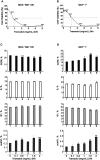
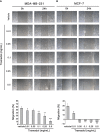
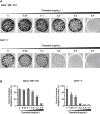
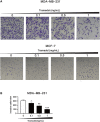
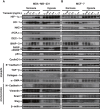

Similar articles
-
The quinoxaline di-N-oxide DCQ blocks breast cancer metastasis in vitro and in vivo by targeting the hypoxia inducible factor-1 pathway.Mol Cancer. 2014 Jan 24;13:12. doi: 10.1186/1476-4598-13-12. Mol Cancer. 2014. PMID: 24461075 Free PMC article.
-
Lutein inhibits proliferation, invasion and migration of hypoxic breast cancer cells via downregulation of HES1.Int J Oncol. 2018 Jun;52(6):2119-2129. doi: 10.3892/ijo.2018.4332. Epub 2018 Mar 23. Int J Oncol. 2018. PMID: 29620169
-
Fucoidan inhibits epithelial-to-mesenchymal transition via regulation of the HIF-1α pathway in mammary cancer cells under hypoxia.Oncol Lett. 2019 Jul;18(1):330-338. doi: 10.3892/ol.2019.10283. Epub 2019 Apr 25. Oncol Lett. 2019. PMID: 31289504 Free PMC article.
-
Inhibitory effect of melatonin on hypoxia-induced vasculogenic mimicry via suppressing epithelial-mesenchymal transition (EMT) in breast cancer stem cells.Eur J Pharmacol. 2020 Aug 15;881:173282. doi: 10.1016/j.ejphar.2020.173282. Epub 2020 Jun 21. Eur J Pharmacol. 2020. PMID: 32580038
-
Involvement of the ERK/HIF-1α/EMT Pathway in XCL1-Induced Migration of MDA-MB-231 and SK-BR-3 Breast Cancer Cells.Int J Mol Sci. 2020 Dec 23;22(1):89. doi: 10.3390/ijms22010089. Int J Mol Sci. 2020. PMID: 33374849 Free PMC article.
Cited by
-
O-Desmethyltramadol Enhanced Anti-Cancer Efficacy over Tramadol Through Non-μ-Opioid Receptor and Differential Cellular Contexts of Human Breast Cancer Cells.Int J Mol Sci. 2025 Apr 27;26(9):4139. doi: 10.3390/ijms26094139. Int J Mol Sci. 2025. PMID: 40362379 Free PMC article.
-
Multifaced Anticancer Potential of Doxorubicin: Spotlight on Breast Cancer.Dis Res. 2025 Mar;5(1):19-36. doi: 10.54457/dr.202402015. Epub 2025 Jan 17. Dis Res. 2025. PMID: 40530298 Free PMC article.
-
Mitochondrial Dysfunction Involved in the Cytotoxicity of Tramadol in Human Endometrial Carcinoma Cells.Int J Mol Sci. 2022 Dec 21;24(1):99. doi: 10.3390/ijms24010099. Int J Mol Sci. 2022. PMID: 36613541 Free PMC article.
-
Pancreatic Cancer and Microenvironments: Implications of Anesthesia.Cancers (Basel). 2022 May 28;14(11):2684. doi: 10.3390/cancers14112684. Cancers (Basel). 2022. PMID: 35681664 Free PMC article. Review.
-
Pain Management in Animals with Oncological Disease: Opioids as Influencers of Immune and Tumor Cellular Balance.Cancers (Basel). 2024 Aug 29;16(17):3015. doi: 10.3390/cancers16173015. Cancers (Basel). 2024. PMID: 39272873 Free PMC article. Review.
References
-
- Lukoseviciene V, Tikuisis R, Dulskas A, Miliauskas P, Ostapenko V. Surgery for Triple-Negative Breast Cancer- Does the Type of Anaesthesia Have an Influence on Oxidative Stress, Inflammation, Molecular Regulators, and Outcomes of Disease? J BUON (2018) 23(2):290–5. - PubMed
LinkOut - more resources
Full Text Sources
Miscellaneous

